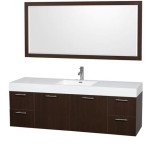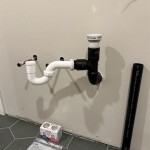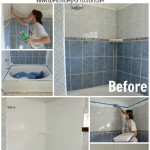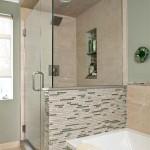How To Fit A Bathroom Vanity Sink With Cabinet
Installing a new bathroom vanity sink with a cabinet can significantly enhance the aesthetic appeal and functionality of a bathroom. This process, while potentially daunting for novice DIYers, can be successfully accomplished with careful planning, the right tools, and a methodical approach. This article provides a comprehensive guide to fitting a bathroom vanity sink with a cabinet, covering essential steps from preparation to final installation and addressing potential challenges.
Before commencing the installation, it's crucial to ensure that the existing plumbing is compatible with the new vanity. This involves measuring existing water supply lines and drain pipes to ascertain whether extensions or modifications will be required. Incompatibility in plumbing configurations can lead to significant delays and additional expenses during the installation process. Furthermore, confirm that the new vanity’s dimensions will fit comfortably within the designated space, accounting for any obstructions like door frames or adjacent fixtures.
Preparing the Bathroom and Removing the Old Vanity
The initial stage involves meticulously preparing the bathroom for the installation. This begins with shutting off the water supply to the existing sink. Typically, shut-off valves are located beneath the sink itself. However, if these are absent or malfunctioning, the main water supply to the house should be turned off to prevent potential flooding. Once the water supply is secured, disconnect the water supply lines from the existing faucet. Use a basin wrench or adjustable wrench to loosen the connections, taking care to have a bucket or towel readily available to catch any residual water.
Next, disconnect the drainpipe from the existing sink. This usually involves loosening a slip nut connecting the P-trap to the tailpiece of the sink drain. Again, be prepared for residual water within the drainpipe, as it can often contain stagnant water and debris. Carefully remove the P-trap and any other connected drain components.
With the plumbing disconnected, the process of removing the old vanity cabinet can begin. Depending on how the vanity is attached to the wall, it may be secured with screws, nails, or adhesive. If screws are visible, remove them using a screwdriver or drill. If the vanity is adhered to the wall, use a utility knife to carefully score along the edges where the vanity meets the wall. This will help to prevent damage to the drywall during removal. In some cases, you may need to gently pry the vanity away from the wall using a pry bar or similar tool. Exercise caution to avoid damaging the wall surface.
After removing the old vanity, thoroughly clean the area where the new vanity will be installed. Remove any debris, old adhesive residue, or other obstructions that could interfere with the installation. Inspect the wall for any damage, such as cracks or holes, and repair as necessary. This may involve patching with drywall compound and sanding smooth.
Finally, locate the wall studs in the area where the vanity will be installed. Studs provide solid support for the vanity cabinet and are essential for ensuring a secure and stable installation. Use a stud finder to locate the studs and mark their positions on the wall. These marks will be used later when attaching the new vanity to the wall.
Installing the New Vanity Cabinet
The installation of the new vanity cabinet begins by carefully positioning it within the designated space. Ensure that the cabinet is level both horizontally and vertically. Use a level to check the top, sides, and front of the cabinet. If the cabinet is not level, use shims underneath the base to make necessary adjustments. Shims are thin pieces of wood or plastic that can be inserted between the cabinet and the floor to compensate for uneven surfaces.
Once the cabinet is level, it is time to secure it to the wall studs. Use the marks made earlier to locate the studs. Pre-drill pilot holes through the back of the cabinet at the stud locations. This will help to prevent the wood from splitting when you drive in the screws. Use appropriate screws that are long enough to penetrate the stud deeply, typically 2-3 inches in length. Secure the cabinet to the wall by driving the screws through the pre-drilled pilot holes and into the studs. Ensure that the cabinet is firmly attached to the wall and that it does not wobble or shift.
If the vanity cabinet is designed with adjustable legs, ensure that these are properly adjusted to provide additional support and stability. Adjust the legs until they are firmly in contact with the floor and that they are evenly distributing the weight of the cabinet. After the cabinet is securely fastened to the wall you can prepare to install the sink into the vanity cabinet. Refer to the manufacturer's instructions for the recommended installation procedure for your specific sink and cabinet model.
Installing the Sink, Faucet, and Plumbing Connections
Installing the sink into the vanity cabinet involves several key steps. First and foremost, ensure that the sink fits properly within the designated opening in the vanity countertop. Some vanities may require minor adjustments to the opening to ensure a snug and secure fit. Carefully lower the sink into the opening, taking care not to scratch or damage the countertop.
Next, install the faucet and drain assembly according to the manufacturer's instructions. This typically involves inserting the faucet through the pre-drilled holes in the sink and securing it from underneath with mounting hardware. The drain assembly includes components such as the drain flange, tailpiece, and pop-up drain stopper. Ensure that all connections are tight and leak-free.
Once the faucet and drain assembly are installed, connect the water supply lines to the faucet. Use Teflon tape on the threads of the connections to ensure a watertight seal. Tighten the connections using a wrench, taking care not to overtighten, which could damage the fittings. Connect the drainpipe to the sink's tailpiece. This usually involves attaching a P-trap to the tailpiece using slip nuts. Ensure that all connections are properly aligned and tightened to prevent leaks.
After all plumbing connections are completed, turn on the water supply to the faucet and check for leaks. Carefully inspect all connections, including the water supply lines, drainpipe, and faucet fittings. If any leaks are detected, immediately turn off the water supply and tighten the connections further. If leaks persist, you may need to disassemble the connections and reapply Teflon tape or replace any damaged components.
Finally, test the drain by filling the sink with water and then opening the drain stopper. Observe the water flow to ensure that it drains smoothly and without any clogs or backups. If the drain is slow or clogged, you may need to use a drain snake to clear any obstructions. Once you are satisfied that the plumbing connections are leak-free and the drain is functioning properly, you can proceed to the final steps of the installation.
Pay careful attention to the manufacturer's recommended torque settings when tightening drain and water supply connections. Over-tightening can damage threads and cause leaks, while under-tightening can lead to drips. Utilizing a torque wrench where appropriate can help achieve the correct tightness and prevent future plumbing issues.
Once the vanity, sink, and plumbing are installed, apply a bead of caulk around the perimeter of the sink where it meets the countertop. This will create a watertight seal and prevent water from seeping underneath the sink. Smooth the caulk with your finger or a caulking tool for a clean and professional finish. Allow the caulk to dry completely before using the sink. Refer to the caulk manufacturer's instructions for the recommended drying time.
Proper ventilation around the plumbing connections underneath the vanity is crucial for preventing moisture buildup and potential mold growth. Ensure that there is adequate airflow in the cabinet area by leaving a small gap between the cabinet back and the wall, or by installing a vent.
Dispose of all packing materials and discarded components responsibly, following local recycling and waste disposal guidelines. Clean up the work area thoroughly, removing any debris, tools, or materials that may have accumulated during the installation process.
Consider adding drawer and cabinet organizers to maximize storage space and improve the functionality of the new vanity. These accessories can help to keep bathroom essentials organized and easily accessible.
Finally, regularly inspect the plumbing connections underneath the vanity for any signs of leaks or corrosion. Addressing any minor issues promptly can prevent more significant problems from developing over time.

Can You Use Kitchen Cabinets For A Bathroom Vanity Nashua Home Design Center

How To Install A Bathroom Vanity

How To Install Or Remove A Bathroom Vanity Homeserve Usa


How To Fit A Vanity Unit Big Bathroom

How To Build A Diy Bathroom Vanity Angela Marie Made

Diy Vanity For Wall Mount Sink Jaime Costiglio

How To Build A Diy Modern Floating Vanity Or Tv Console

6 Reasons To Include A Vanity Unit In Your Bathroom Big

How To Install A Bathroom Vanity And Sink
Related Posts







